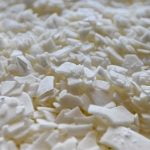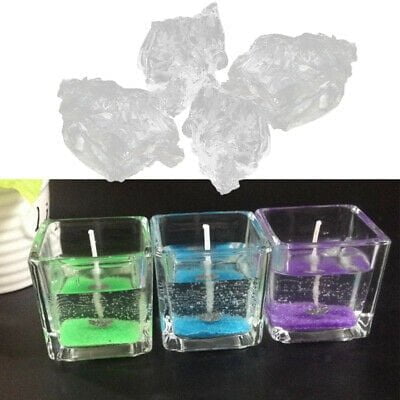Making candles is a craft that requires careful consideration of all elements involved, including the type of wick used. The choice of wick can greatly impact the performance and overall quality of a candle. In order to create candles that burn evenly, efficiently, and safely, it is crucial to select the best wicks for the task at hand. Whether you are a seasoned candle maker or just starting out, understanding the importance of choosing the right wicks is essential.
The right wick ensures that your candle burns consistently from start to finish with minimal issues such as mushrooming or tunneling. It also contributes to optimal fragrance throw and wax consumption.
With so many options available in the market, it can be overwhelming to determine which wicks are best suited for your specific needs. This article will provide a comprehensive guide to help you navigate through the various types of candle wicks and make informed decisions when it comes to selecting the perfect wick for your candles.
From flat braided wicks to wooden wicks, each type has its own set of advantages, disadvantages, and ideal applications. We will delve into these different types of wicks and explore their unique characteristics and performance considerations. Additionally, we will discuss factors such as candle size, wax type compatibility, scent load, and color load that should be taken into account when selecting suitable wicks.
By understanding these factors and learning about testing methods and troubleshooting techniques for common issues related to candle wicks, you will be equipped with the knowledge needed to ensure optimal results in your candle making endeavors. Furthermore, we will explore DIY wick making as well as eco-friendly options for those who prioritize sustainability in their craft.
This article aims to provide essential guidelines for choosing the perfect wick through an in-depth analysis of different candle types and associated requirements. By following these guidelines and utilizing the tips provided throughout this article, you can enhance your candle making experience and achieve exceptional results with every creation.
Understanding the Different Types of Candle Wicks
Flat braided wicks are one of the most common types of wicks used in candle making. These wicks are made by weaving together flat strands of cotton or other fibers. They come in various sizes to accommodate different candle diameters and burn rates.
One major advantage of flat braided wicks is their stability. They tend to burn consistently and produce a steady flame throughout the life of the candle. This makes them suitable for container candles, as well as pillar candles. Flat braided wicks also have a good balance between fuel consumption and heat output, resulting in efficient burning.
However, there are some drawbacks to using flat braided wicks. For certain types of wax, such as soy or vegetable-based waxes, these wicks may not perform as well as others. They can sometimes struggle with pooling issues or create sooty smoke if they are not properly trimmed or maintained.
To achieve the best results with flat braided wicks, here are some tips:
- Choose the right size: Consider the diameter of your candle when selecting a flat braided wick. If the wick is too thin for your candle, it may lead to poor burning performance or tunneling. On the other hand, if the wick is too thick, it may cause excessive smoking or uneven burning.
- Trim regularly: Keep the length of your flat braided wick between 1/4 to 1/8 inch before every burn to prevent mushrooming and excess soot production.
- Test burn: Before starting production on a large scale, conduct test burns with different sizes of flat braided wicks to determine which one performs best with your specific wax and fragrance load combination.
By understanding the pros and cons of using flat braided wicks and following these tips for success, you can optimize your candle making process and create candles that burn beautifully and consistently.
Factors to Consider When Selecting Wicks for Candle Making
Choosing the right wick is crucial in candle making as it significantly impacts burn performance and overall candle quality. There are several factors to consider when selecting wicks for your candles, including candle size and diameter, wax type compatibility, and scent and color load. Understanding how these factors influence wick selection will help you achieve optimal burning results.
– Candle Size and Diameter: The size and diameter of your candle play a vital role in determining the appropriate wick size. A wick that is too small may result in tunneling, where the wax does not fully melt to the edge, leaving unmelted wax along the sides of the container.
On the other hand, a wick that is too large can cause excessive flame height, soot buildup, or mushrooming. It is essential to match the wick size with the dimensions of your candle for an even and consistent burn.
– Wax Type Compatibility: Different types of wax require different types of wicks for optimal burning. For instance, soy wax tends to be softer than other types of wax, requiring larger or differently constructed wicks to accommodate its characteristics. Beeswax also has unique properties that may necessitate specific wick options. It is important to research and test various wicks with your chosen wax type to find the perfect match for efficient burning.
– Scent and Color Load: The addition of fragrance oils or dyes can affect how a candle burns and performs. Some scents or dyes may require specific adjustments in wick selection to ensure proper fragrance throw and an even burn throughout the candle’s lifespan. Testing different combinations of scent load and color load with various wicks will help determine which combination yields the best results.
Consider these factors carefully when selecting your candle wicks to achieve the desired burn performance and ensure customer satisfaction. Conducting burn tests with different wick options is highly recommended to determine the ideal combination of wick size and type for your specific candle-making project.
| Factors to Consider | Description |
|---|---|
| Candle Size and Diameter | The size and diameter of the candle influence the appropriate wick size. |
| Wax Type Compatibility | Different wax types may require specific wick options for optimal burning. |
| Scent and Color Load | The addition of fragrance oils or dyes can impact wick selection for proper burn quality. |
Testing and Troubleshooting Candle Wicks
When it comes to candle making, selecting the right wick is just the first step in achieving a successful burn. To ensure optimal results and avoid common wick-related issues, it is essential to conduct thorough testing and troubleshooting. This section will guide you through key steps to help you achieve the perfect burn every time.
Conducting Burn Tests
Before producing a large batch of candles, it is crucial to perform burn tests with different wick sizes. This step will determine the ideal wick size for your specific candle design and wax combination. To do this, prepare several containers or molds using your desired wax and fragrance load.
Start by trimming each wick to the same length, ensuring they are all equal in height. Light one candle at a time and observe how each burns. Look for signs such as tunnelling (when the wax only melts in the center of the container), mushrooming (the top of the wick forms a mushroom-like shape), or excessive smoking.
Measure how long it takes for each candle to achieve a full melt pool, where the entire surface of the container is covered with melted wax. Note down any observations regarding flame height, scent throw, and overall burn quality. Repeat this process with varying wick sizes until you find the one that provides an even burning experience with minimal issues.
Addressing Common Wick Issues
Even with careful selection, some wicks may still present certain problems during burning. Two common issues are wick drowning and mushrooming.
Wick drowning occurs when a flame has difficulty reaching or staying lit due to excess wax pooling around the base of the wick. To prevent this issue, make sure your candle’s fragrance load does not exceed recommended limits, as high concentrations can contribute to excessive pooling. Additionally, avoid drafts that could disturb the flame and cause uneven melting.
Mushrooming, on the other hand, refers to excessive carbon buildup at the tip of the wick, which can lead to an undesirable sooty burn. To minimize mushrooming, ensure your wick is properly trimmed before each use. Trimming the wick to about 1/4 inch will help maintain a clean flame and reduce carbon buildup.
Adjusting Wick Choices for Unique Candle Formulations
It is essential to consider that different candle formulations might require specific adjustments to achieve optimal burning results. For example, candles with a high fragrance or dye load may need larger wicks to generate enough heat for efficient burning. Conversely, candles with a low scent or color concentration may require smaller wicks to prevent excess pooling.
Additionally, certain types of wax may have different burning characteristics that influence the choice of wick. Soy wax, for instance, tends to create a cooler burn compared to paraffin wax. Therefore, soy candles often benefit from larger wicks for adequate heat generation.
By carefully considering factors such as fragrance load, dye concentration, and wax type in relation to your chosen wick size, you can troubleshoot any issues and customize your candle formulation for optimal performance.
With these steps in mind, testing and troubleshooting your candle wicks will allow you to fine-tune your creations and achieve exceptional burning performance. Remember that every candle design and formulation is unique, so don’t be afraid to experiment with different combinations until you find the perfect match.
DIY Wick Making
One of the fascinating aspects of candle making is the ability to create your own custom wicks. DIY wick making allows candle makers to have complete control over the size, material, and performance of their candles. This section will explore the art of crafting homemade wicks, providing a step-by-step guide, essential tools and materials, as well as discussing the advantages and drawbacks of this approach.
Materials and Tools Needed: An Essential Checklist for Making Your Own Wicks
To embark on the journey of DIY wick making, there are several materials and tools that you’ll need to have on hand:
- Wick Material: Popular choices for DIY wicks include cotton yarn, hemp twine, or even strips of paper. Each material has its own unique characteristics that will affect the performance of your candles.
- Scissors: A good pair of sharp scissors is essential for cutting your chosen wick material to the desired length.
- Wick Sustainers (Tabs): These metal or wooden devices serve as anchors at the base of the candle and hold the wick in place during burning. They come in various sizes to accommodate different candle containers.
- Double-Sided Tape: This will be used to attach the sustainers onto the bottom of your candle containers before pouring in the wax.
- Ruler or Measuring Tape: Accurate measurement is crucial when creating custom wicks, so having a ruler or measuring tape on hand will ensure precision.
- Pencil or Chopstick: To help secure and center your wick sustainer at the bottom of your container before pouring in the wax.
Step-by-Step Guide to Creating Homemade Wicks: Techniques, Tips, and Safety Precautions
Once you have gathered all the necessary materials and tools, follow these steps to create your own custom candle wicks:
- Measure and cut your selected wick material to the desired length. It should be long enough to reach from the bottom of your candle container to about 1 inch above the top surface of the wax.
- Attach a wick sustainer (tab) at one end of the wick material. Secure it tightly using double-sided tape or by tying a knot if using a thick material like hemp twine.
- Place the sustainer with the attached wick into the bottom center of your candle container. Use a pencil or chopstick to hold it in place and ensure it remains centered.
- Pour your desired wax into the container, taking care not to disturb the positioned wick. Leave some space at the top for any additional decorative elements.
- Allow the wax to cool and solidify completely before trimming the wick to your desired length, typically around ¼ inch above the surface of the wax.
When working with homemade wicks, it’s important to exercise caution and follow safety precautions throughout the process. Always work in a well-ventilated area, away from flammable materials, and use heat-resistant gloves when handling hot wax.
Advantages and Drawbacks of Homemade Wicks: Is It Worth the Effort?
Crafting custom candle wicks offers several advantages for candle makers:
- Customization: By making your own wicks, you can tailor them precisely to match your specific candle size and burn preferences. This level of customization allows for optimal performance and ensures each candle burns evenly.
- Cost-effective: DIY wick making can be a more budget-friendly option compared to purchasing premade wicks in bulk quantities.
- Creativity: Homemade wicks provide an opportunity for creative expression in candle making, allowing you to experiment with different materials, sizes, and designs for unique visual appeal.
However, there are also some drawbacks to consider:
- Time-consuming: Crafting homemade wicks can be a time-consuming process, especially when making them in large quantities. This may not be ideal for those looking for a quick and efficient candle making experience.
- Trial and error: Creating your own wicks requires experimentation and testing to find the perfect combination of materials and sizes that work best with your specific candle formulations.
- Consistency: Achieving consistent results with homemade wicks may be more challenging compared to using commercially manufactured wicks, which undergo rigorous quality control processes.
Eco-friendly Wick Options
Candle making is not only a creative and enjoyable hobby but also an opportunity to make environmentally conscious choices. For those who are concerned about the impact of their candle making on the environment, there are several eco-friendly wick options available. These sustainable alternatives offer a greener approach to candle making, ensuring that your hobby aligns with your values.
One of the most popular eco-friendly wick choices for candle makers is cotton wicks. Made from natural fibers, cotton wicks are biodegradable and renewable. They offer a clean burn and are free from harmful chemicals or additives. Cotton wicks also have excellent burning properties, providing an even flame with minimal smoke or soot. They are suitable for various types of candles, including container candles, pillar candles, and taper candles.
Another sustainable option to consider is paper wicks. These wicks are typically made from recycled materials such as paper or cardboard and coated in a thin layer of wax. Paper wicks offer a low carbon footprint and can be composted after use. They provide a stable flame and good burn performance but may require trimming more frequently compared to other wick types.
Hemp wicks have also gained popularity among environmentally conscious candle makers. Hemp, a highly sustainable plant, yields strong fibers that can be used to create durable wicks. Hemp wicks offer a slow burn and produce very little soot or smoke. They are ideal for larger-sized candles or those with higher fragrance loads.
Overall, by choosing eco-friendly wick options like cotton, paper, or hemp, you can ensure that your candle making process is more sustainable and reduces environmental impact. These options not only provide excellent burn performance but also contribute to reducing waste and conserving natural resources.
- To make your candle making process more environmentally friendly:
- Consider using cotton wicks made from natural fibers.
- Explore paper wicks made from recycled materials.
- Try hemp wicks for a sustainable and durable option.
Remember, the choice of wick is crucial in candle making as it affects burn performance and overall candle quality. By opting for eco-friendly wick options, you can enjoy your candle making hobby while minimizing the impact on the planet.
Choosing the Best Wicks for Different Candle Types
When it comes to candle making, choosing the right wicks for different types of candles is crucial for achieving optimal burning performance. Each type of candle requires a specific wick style and technique to ensure even burns and desired results. In this section, we will provide a detailed analysis of the best wicks for various candle types.
Container Candles: Optimal Wick Selection and Tips for Achieving Even Burns
Container candles are one of the most popular choices among candle makers due to their versatility and ease of use. When selecting wicks for container candles, it is important to consider the diameter and depth of the container.
For smaller containers with a diameter of 2 inches or less, cotton core or paper-cored wicks are recommended as they provide a stable burn with minimal mushrooming. However, if you are using a larger container with a diameter greater than 2 inches, it is best to opt for cored or wooden wicks to ensure an adequate burn pool.
To achieve even burns in container candles, it is essential to trim the wick before each use. Trimming the wick to about ¼ inch will help prevent excessive smoking and soot buildup while promoting a clean and steady flame.
Pillar Candles: The Most Suitable Wick Styles and Techniques for Successful Core Burning
Pillar candles require a different approach when it comes to selecting wicks due to their unique structure. To achieve successful core burning in pillar candles, square braided or flat braided cotton wicks are recommended as they have excellent rigidity and stability.
The size of the pillar candle also plays a significant role in determining the appropriate wick choice. For smaller pillar candles, a thinner wick may be sufficient, while larger pillar candles with thicker diameters require thicker or multiple wicks for an optimal burn.
During the initial burning process of pillar candles, it is important to allow the wax to melt completely across the entire surface. This will help prevent tunneling and ensure an even burn throughout the life of the candle.
Taper Candles: Understanding Wick Requirements in Long, Thin Candles
Taper candles, with their long and thin shape, present unique challenges when it comes to wick selection. It is crucial to choose wicks that are specifically designed for taper candles to achieve consistent burning performance.
The ideal wick for taper candles is a tightly braided cotton wick with a thin diameter. This type of wick provides a steady flame without excessive dripping or smoking. It is important to select a wick that matches the diameter of your taper candle for optimal results.
When burning taper candles, it is recommended to use candle holders with proper airflow to prevent overheating and uneven burning. Additionally, be sure to trim the wick before each use and avoid placing tapers in drafts or near flammable materials for safety reasons.
By carefully considering these factors and selecting the appropriate wicks for different candle types, you can enhance your candle making experience and enjoy beautiful, well-performing candles every time.
Extra Tips and Tricks to Enhance Your Candle Making Experience
When it comes to candle making, choosing the right wick is essential for achieving optimal burn performance. However, it’s not just about selecting the appropriate wick type; there are additional tips and tricks that can enhance your overall candle making experience. Paying attention to wick trimming and maintenance, selecting the right wick tab, and finding wicks that complement scent diffusion can make a noticeable difference in the quality of your candles.
One important aspect of candle maintenance is proper wick trimming. Trimming your wicks before each burn helps to prevent excessive smoke, soot, and mushrooming. It also ensures a clean and even burn throughout the life of the candle.
To trim your wicks correctly, use a pair of scissors or a wick trimmer to cut them down to about ¼ inch in length. Keeping the wick at this optimal length will promote better burning efficiency and reduce potential issues such as tunneling.
In addition to trimming, selecting the right wick tab is crucial for ensuring stability and performance. The tab refers to the metal piece at the base of the wick that anchors it to the bottom of the container or mold. Different types of tabs offer varying levels of stability and support for the flame.
For instance, a large centering tab is often suitable for container candles as it keeps the flame centered while providing structural reinforcement. On the other hand, smaller corner tabs are preferred for taper candles as they maintain stability without interfering with their slender shape.
Furthermore, enhancing candle fragrance throw is another way to elevate your candle making experience. Some wicks are specifically designed to improve scent diffusion and maximize fragrance release into the air when lit.
For example, cotton core or paper core wicks are known for their ability to enhance fragrance throw by providing a consistent fuel source for more efficient burning in scented candles. Consider experimenting with different wick types to find the ones that best complement the scent diffusion of your chosen fragrance oils.
By paying attention to these extra tips and tricks, you can take your candle making experience to the next level. Proper wick trimming and maintenance, selecting the right wick tab, and finding wicks that enhance fragrance throw can greatly improve the quality and performance of your candles. Experimentation and customization are key in this art form, so don’t be afraid to try different techniques and techniques to find what works best for your unique candle creations.
Conclusion
In conclusion, choosing the right wick is crucial for successful candle making. With a comprehensive understanding of the different types of wicks available, such as flat braided wicks, square braided wicks, cored wicks, and wooden wicks, candle makers can select the most suitable option for their specific needs. By considering factors like candle size and diameter, wax type compatibility, and scent and color load, one can ensure optimal burn performance and quality.
Testing and troubleshooting candle wicks is an essential step in achieving desired results. Conducting burn tests to determine the ideal wick size and addressing common issues like wick drowning, mushrooming, and tunneling are necessary to maintain a consistent burn. Additionally, adjusting the choice of wicks for unique candle formulations can help overcome specific challenges that may arise.
For those who prefer a more personalized touch, DIY wick making offers an opportunity to craft custom candle wicks. This process requires materials like cotton or paper and involves following a step-by-step guide with safety precautions in mind. While homemade wicks have advantages in terms of customization, there are also drawbacks to consider before deciding if it is worth the effort.
Lastly, eco-friendly options are gaining popularity among environmentally conscious candle makers. Cotton and hemp wicks provide sustainable alternatives to traditional materials, while paper-based wicks offer their own set of benefits and drawbacks.
By following these essential guidelines and taking into account the specific requirements of different types of candles – such as container candles, pillar candles, and taper candles – candle makers can enhance their craft by selecting the perfect wick. Through proper trimming and maintenance techniques, choosing appropriate tab types for stability, ensuring efficient fragrance throw with complementary wicks – these extra tips will further elevate your candle making experience.
In essence, choosing the perfect wick for your candles requires careful consideration of various factors along with experimentation through testing and troubleshooting. Whether you prefer premade options or enjoy the art of making your own custom wicks, the right choice can greatly impact the burn performance, aesthetics, and overall quality of your candles. With these essential guidelines, candle makers can confidently select the best wicks for their unique creations and achieve the desired results.
Frequently Asked Questions
What type of wick is best for candles?
The type of wick that is best for candles depends on the specific characteristics of the candle and the desired burn performance. Cotton wicks are commonly used and are suitable for most candle types. They provide a consistent burn and are readily available in various sizes.
Another popular option is a zinc-core wick, which has a metal core to help keep it upright during burning. This type of wick is ideal for large or scented candles that require a stronger flame to melt the wax evenly. It’s important to consider factors such as the diameter of the candle, type of wax, and fragrance load when selecting the best wick.
What kind of wicks are best for soy candles?
When it comes to soy candles, cotton or cotton-paper blend wicks are often recommended as they work well with soy wax’s lower melting point and tend to produce a cleaner burn. Soy wax tends to have a cooler burning temperature compared to other types of wax, so using a wick that is specifically designed for soy candles helps ensure optimal performance and minimize issues like mushrooming or sooting.
These types of wicks have been tested with soy wax formulations and their characteristics are tailored to match its specific properties.
Are wood wicks better than wax wicks?
Whether wood wicks are better than traditional wax wicks depends on personal preference and the desired aesthetic and sensory experience. Wood wicks can create a cozy ambiance with their crackling sound similar to a fireplace, which some people find enjoyable during candle burning. Additionally, wood wicks have good capillary action, meaning they can draw up melted wax more efficiently than traditional cotton or zinc-core wicks.
However, wood wicks require careful maintenance as they may need trimming between burns and can be sensitive to drafty conditions. Moreover, wood wicks might not be suitable for all types of candles or wax blends, so it’s important to consider compatibility with different materials before deciding if wood wicks are better than traditional options.

Welcome to my candle making blog! In this blog, I will be sharing my tips and tricks for making candles. I will also be sharing some of my favorite recipes.





